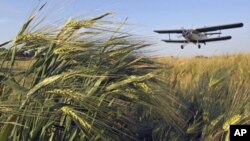The most complete map ever of wheat's genetic blueprint could provide plant breeders with new clues to improving one of the world’s most important food crops.
The new map includes tens of thousands of genetic signposts on wheat's DNA molecules. These markers will help guide researchers and breeders who are working to better understand how the plant copes with salty soil or drought, for example.
Better varieties
Such insights, theoretically, will allow them to create better varieties of wheat much more quickly than in the past.
“We knew this was a necessary thing because breeders and researchers who were working on wheat were crying out for this sort of resource,” says Mike Bevan at the U.K. research institute, the John Innes Centre.
Wheat is among the world’s most widely consumed grains. And with the global population expected to reach nine billion by 2050, Bevan says efforts to improve the crop are essential.
But while the maize and rice genomes were published years ago, unraveling the wheat genome has been especially hard.
For one thing, it’s huge. The map just published in Nature identified nearly 100,000 genes.
“Given that the human genome contains about 25,000 genes, this was a massive gene set,” Bevan says.
Complicated genes
That’s because wheat evolved thousands of years ago from a hybrid of three other plants, and it still carries genetic material from all of them.
Also complicating the decoding effort is the fact that big sections of the wheat genome are made up of repetitive stretches of DNA. Bevan says they serve a purpose, but they make assembling the map that much harder.
"When all your jigsaw pieces are approximately the same shape, you don’t really know where they fit in your jigsaw [puzzle].”
That jigsaw puzzle is still not fully completed but this work could start to bear fruit in the next few years.
“I don’t think it’s unreasonable to expect that in five years or so you’ll start to see some lines in the field that are there because of the sequence data we’ve generated," Bevan says. "But I think the true impact will be felt in the much longer term.”
He says in the long run the data will make it easier for scientists to improve the grain by incorporating useful traits from different types of wheat, or even their wild relatives.
The new map includes tens of thousands of genetic signposts on wheat's DNA molecules. These markers will help guide researchers and breeders who are working to better understand how the plant copes with salty soil or drought, for example.
Better varieties
Such insights, theoretically, will allow them to create better varieties of wheat much more quickly than in the past.
“We knew this was a necessary thing because breeders and researchers who were working on wheat were crying out for this sort of resource,” says Mike Bevan at the U.K. research institute, the John Innes Centre.
Wheat is among the world’s most widely consumed grains. And with the global population expected to reach nine billion by 2050, Bevan says efforts to improve the crop are essential.
But while the maize and rice genomes were published years ago, unraveling the wheat genome has been especially hard.
For one thing, it’s huge. The map just published in Nature identified nearly 100,000 genes.
“Given that the human genome contains about 25,000 genes, this was a massive gene set,” Bevan says.
Complicated genes
That’s because wheat evolved thousands of years ago from a hybrid of three other plants, and it still carries genetic material from all of them.
Also complicating the decoding effort is the fact that big sections of the wheat genome are made up of repetitive stretches of DNA. Bevan says they serve a purpose, but they make assembling the map that much harder.
"When all your jigsaw pieces are approximately the same shape, you don’t really know where they fit in your jigsaw [puzzle].”
That jigsaw puzzle is still not fully completed but this work could start to bear fruit in the next few years.
“I don’t think it’s unreasonable to expect that in five years or so you’ll start to see some lines in the field that are there because of the sequence data we’ve generated," Bevan says. "But I think the true impact will be felt in the much longer term.”
He says in the long run the data will make it easier for scientists to improve the grain by incorporating useful traits from different types of wheat, or even their wild relatives.






